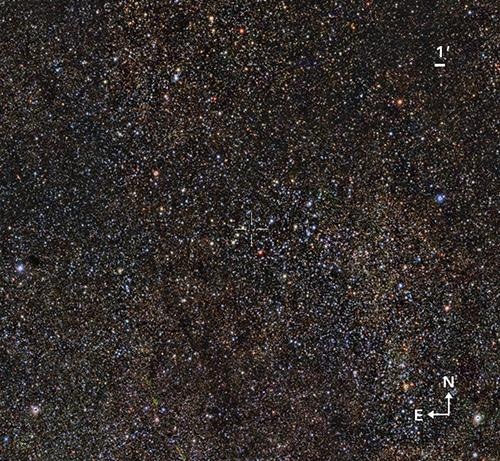Jun 3 2021
Under the guidance of the Stellar Astrophysics Group from the University of Alicante (UA), an international group of astrophysicists has found a huge cluster of stars of intermediate age in the direction of the Scutum constellation.
 Region of the sky in which Valparaíso (1) is located. Image Credit: Gabriel Pérez Díaz, SMM (IAC)
Region of the sky in which Valparaíso (1) is located. Image Credit: Gabriel Pérez Díaz, SMM (IAC)
The study was also led by the Instituto de Astrofísica de Canarias (IAC) and the University of Valparaíso (Chile).
The object has been dubbed Valparaíso 1 and is situated some 7000 light-years away from the Sun and includes a minimum of 15,000 stars.
For detecting the object, the researchers integrated observation from ESA’s Gaia satellite and several ground-based telescopes, such as the Isaac Newton Telescope at the Roque de los Muchachos Observatory (Garafía, La Palma, Canary Islands).
The findings of the study have been published in the Monthly Notices of the Royal Astronomical Society (MNRAS) journal.
Open clusters include groups of stars that were born together, tend to move together, and are held together by gravity. Thus, they are natural laboratories for studying the physics behind them and the lives of stars.
The more stars present in a cluster, the more beneficial it is, as the bigger sample offers a greater likelihood of identifying stars in less frequent evolutionary phases.
This is the reason for astronomers to search for the most enormous clusters present in the Milky Way Galaxy, those with more than 10,000 stars. Until two decades ago, it was believed that these clusters are formed only in faraway galaxies with strange properties.
However, searches by astronomers have helped people know that a dozen juvenile massive clusters (below 25 million years old) and some very old ones (thousands of millions of years old), which are descendants of former young clusters, exist.
Yet, there are barely any huge clusters recognized with intermediate ages, and it was not evident if these do not live, or if they had not yet been discovered.
The so-called Valparaíso 1, the recently discovered cluster, is located nearly 7000 light-years away from the sun and contains a minimum of 15,000 stars.
The sudden finding of this cluster, in a well-examined part of the sky, indicates that several other huge clusters might be concealed in the high-density star fields, which could be found by the observers by looking toward the center of the Milky Way Galaxy.
Valparaíso 1 contains dozens of stars sufficiently bright to be observable through an amateur telescope, but they are lost in the middle of a crowd of stars which don’t belong to the cluster, but which are in front of it or behind it, and which disguise the structure of the cluster.
Ignacio Negueruela, Study First Author and Researcher, University of Alicante
“Previous searches tried to locate open clusters, but Valparaíso 1 does not look like a cluster similar to those which we usually find, and that is why it was not discovered before”, stated Ricardo Dorda, an IAC researcher who is a co-author of this study.
The cluster could be identified through the Gaia satellite of the European Space Agency (ESA), a space telescope that offers extremely precise distances and positions of stars present very far, and with this data, one can quantify the small motions throughout the sky by the stars all these years.
By integrating all the available data, astronomers can detect clusters as groups of stars located at the same distance from the Earth, moving jointly, groups of stars that can be easily detected using physics compared to just by searching for them in the sky.
When the team found this cluster, they employed telescopes at the Las Campanas Observatory (in Chile) and the Isaac Newton Telescope (INT) at the Roque de los Muchachos Observatory (Garafía, La Palma, Canary Islands) to infer the physical properties of its stars.
Cúmulo estelar abierto Valparaíso 1
Open star cluster Valparaíso 1. Video Credit: Gabriel Pérez Díaz, SMM (IAC).
Journal Reference:
Negueruela, I., et al. (2021) A massive open cluster hiding in full sight. Monthly Notices of the Royal Astronomical Society. doi.org/10.1093/mnras/stab1117.